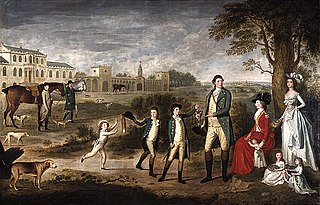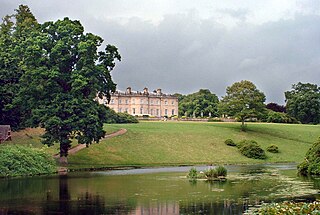
Earl of Rosslyn is a title in the Peerage of the United Kingdom. It was created in 1801 for Alexander Wedderburn, 1st Baron Loughborough, Lord Chancellor from 1793 to 1801, with special remainder to his nephew Sir James St Clair-Erskine, as Wedderburn had no surviving issue of his own. Wedderburn had already been created Baron Loughborough, of Loughborough in the County of Leicester, in the Peerage of Great Britain in 1780, with normal remainder to the heirs male of his body, and Baron Loughborough, of Loughborough in the County of Surrey, in the Peerage of Great Britain in 1795, with the same remainder as the earldom. The 1780 barony became extinct upon his death, but the 1795 barony and the earldom passed, by the special remainder, to his nephew, who thus became the second Earl of Rosslyn. The second Earl was a Lieutenant-General in the Army and also held political office as Lord Privy Seal and Lord President of the Council.

Earl of Cottenham, of Cottenham in the County of Cambridge, is a title in the Peerage of the United Kingdom. It was created in 1850 for the prominent lawyer and Whig politician Charles Pepys, 1st Baron Cottenham. ) He served as Lord Chancellor from 1836 to 1841 and from 1846 to 1850. Pepys had already been created Baron Cottenham, of Cottenham in the County of Cambridge, in 1836, and was made Viscount Crowhurst, of Crowhurst in the County of Surrey, at the same time he was given the earldom. These titles are also in the Peerage of the United Kingdom. The viscountcy is used as a courtesy title for the Earl's eldest son and heir apparent.

Baron Leigh has been created twice as a hereditary title, once in the Peerage of England and once in the Peerage of the United Kingdom. The writer Jane Austen is associated with this dynasty.

Thomas Anson, 1st Viscount Anson was a British politician and peer from the Anson family.

There have been four baronetcies created for members of the Acland family, which originated in the 12th century at the estate of Acland in the parish of Landkey, North Devon, two in the Baronetage of England and two in the Baronetage of the United Kingdom.

There have been five baronetcies of the United Kingdom created for a person with the surname Erskine, two in the Baronetage of Nova Scotia, one in the Baronetage of Great Britain and two in the Baronetage of the United Kingdom. Two of the creations are extant as of 2010.
The Fletcher, later Aubrey-Fletcher Baronetcy, of Clea Hall in the County of Cumberland, is a title in the Baronetage of Great Britain. It was created on 20 May 1782 for Henry Fletcher, a Director of the Honourable East India Company and Member of Parliament. He was a descendant of Philip Fletcher, whose brother Sir Richard Fletcher was the father of Sir Henry Fletcher, 1st Baronet, of Hutton in le Forest. Fletcher was succeeded by his son, Henry, the second Baronet. He was High Sheriff of Cumberland from 1810 to 1811. His grandson, the fourth Baronet, was a prominent Conservative politician. In 1903 he assumed by Royal licence the additional surname of Aubrey on inheriting the Aubrey estates on the death of Charles Aubrey. Aubrey-Fletcher died childless and was succeeded by his younger brother, Lancelot, the fifth Baronet. He assumed by Royal licence the additional surname of Aubrey on succeeding to the title in 1910. His eldest surviving son, Henry, the sixth Baronet, was Lord-Lieutenant of Buckinghamshire from 1954 to 1961. He was succeeded by his son, John, the seventh Baronet. He was High Sheriff of Buckinghamshire in 1961. As of 2008 the title is held by his son, Henry, the eighth Baronet, who succeeded in 1992. He is Lord-Lieutenant of Buckinghamshire since 2006.

There have been three baronetcies created for persons with the surname Burdett, two in the Baronetage of England and one in the Baronetage of Ireland. As of 2008, two of the creations are extant while one is dormant.
There have been four baronetcies for persons with the surname Blake, one in the Baronetage of Ireland, two in the Baronetage of Great Britain and one in the Baronetage of the United Kingdom. Two of the creations are extant as of 2010. The Blake Baronetcy, of Menlough in the County of Galway, was created in the Baronetage of Ireland on 10 July 1622 for Valentine Blake, Mayor of Galway in 1611 and 1630 and a member of the Irish House of Commons for County Galway. His grandfather Thomas Blake had preceded him as Mayor. The second Baronet was a member of the Irish Parliament for Galway Borough. The third Baronet represented both County Galway and Galway Borough in Parliament. The sixth Baronet was a member of the Irish House of Commons for County Galway. He was the first Catholic gentlemen of distinction to join William of Orange. The twelfth Baronet represented Galway Borough in the British House of Commons. The fourteenth Baronet was high sheriff of County Galway in 1872. See also the Blake Baronetcy of Twizell Castle below.
There have been six baronetcies created for persons with the surname of Lawson, two in the Baronetage of England and four in the Baronetage of the United Kingdom. Two creations are extant as of 2010.
There have been six baronetcies created for persons with the surname Brooke, one in the Baronetage of England, one in the Baronetage of Ireland and four in the Baronetage of the United Kingdom. As of 2015 four of the creations are extant, though one has been subsumed into a peerage.
Charles Anderson-Pelham, 1st Baron Yarborough FRS FSA was a British politician.

There have been three baronetcies created for persons with the surname Chichester, one in the Baronetage of England and two in the Baronetage of the United Kingdom. Only the 1641 creation is extant.

There have been four baronetcies created for persons with the surname Miller, two in the Baronetage of England, one in the Baronetage of Great Britain and one in the Baronetage of the United Kingdom. Two of the creations are extant as of 2008.

John Douglas, 7th Marquess of Queensberry, styled Lord John Douglas from May to December 1837, was a Scottish Whig politician.

The St John, later St John-Mildmay Baronetcy, of Farley in the County of Southampton, is a title in the Baronetage of Great Britain. It was created on 9 October 1772 for Paulet St John, Member of Parliament for Winchester and Hampshire. The second Baronet represented Hampshire in the House of Commons. The third Baronet was Member of Parliament for Westbury, Winchester and Hampshire. He married Jane, daughter of Carew Mildmay, and assumed the additional surname of Mildmay. The fourth Baronet sat as Member of Parliament for Winchester. The title became dormant in 1955 on the death of the tenth Baronet. In 1998 Walter John Hugh St John-Mildmay successfully proved his right to the title and became the eleventh Baronet.
Sir Samuel Brise Ruggles-Brise was a British Conservative politician, and owner of Spains Hall, Essex.
Sophia Catherine Chichester was an English patron of religious and political unorthodoxy. She supported the work of reformers including Robert Owen and Richard Carlile, and was president of the British and Foreign Society for the Promotion of Humanity and Abstinence from Animal Food. Along with her sister, Georgina Welch, she has been described as "a unique case of upper-class female radicalism in early Victorian England."
John Cavendish Browne, 3rd Baron Kilmaine was an Anglo-Irish politician and landowner. He was an Irish representative peer (1849–73).
Georgiana Fletcher Welch was an English patron of religious and political unorthodoxy.











